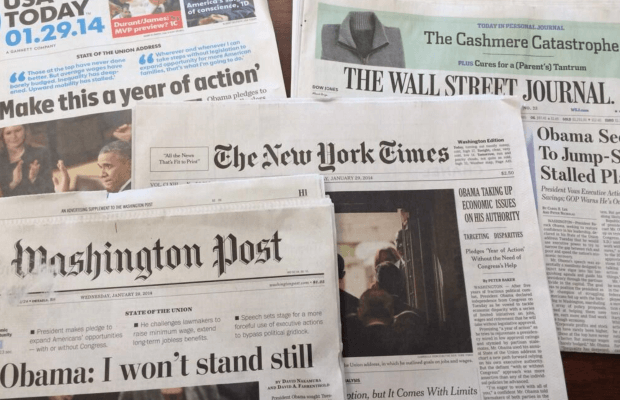A July 20 report, analyzing news content from The New York Times and The Washington Post, found that Republican politicians get roughly 2.5 times as many mentions as Democrats.
The report, produced by a progressive nonprofit Media Matters, was shared widely on social media. Many readers interpreted its findings as evidence of media bias.
But does the report really tell us that much? I am a researcher studying political communication and I have examined the last 40 years of U.S. political coverage in great detail. It’s unsurprising that, in a time when Republicans dominate politically, they also dominate in political news coverage.
Perceived bias
Media bias is an animating topic in American politics. In a 2017 poll, 45 percent of Americans surveyed said that they saw a great deal of bias in the news media.
A common rallying cry among conservatives is that the media have a liberal bias. Surveys repeatedly show the overwhelming proportion of reporters identify as Democrats, which further reinforces the perception among conservative Americans that reporters are biased against them.
At the same time, many liberals view the media as biased towards conservatives, believing that the corporate media is subordinate to the corporate elites. This is seen as especially true in the media environment that’s heavily consolidated among a handful of powerful corporate actors.
In short, many on both ends of the political spectrum view the media as biased against their political side. In fact, the majority of Americans cannot name a single news outlet that they believe reports the news objectively.
Studying the media
Despite these widespread beliefs, academics are unable to agree on whether the media are, in fact, biased.
Studies on media bias take different approaches. Some studies simply compare differences in coverage tone or volume across different presidential administrations. Another approach looks for bias in newspaper endorsements of politicians. More sophisticated attempts try to score an outlet’s slant by looking at the number of citations of left-wing and right-wing think tanks or loaded political phrases associated with the Democratic or Republican Party. Taken together, however, these studies produced mixed results.
One of the reasons that it’s so difficult to measure bias is that researchers struggle to establish a baseline of what the unbiased coverage should look like. Take a recent example, when the GOP complained on Twitter that 92 percent of immigration news coverage related to President Donald Trump’s policies is negative.
New study from the Media Research Center finds that 92% of news coverage related to @realDonaldTrump’s immigration policy is negative. Help us hold the mainstream media accountable ➡️ https://t.co/DFRQaX1jOehttps://t.co/3WiFNZo6oI
— GOP (@GOP) July 28, 2018
That number, on its own, doesn’t indicate bias, since we don’t know what the media coverage would look like in the same circumstances, but with a Democrat in the White House. If a Democratic president imposed similar immigration policies and the resulting coverage was more positive, that would indicate political bias.
Since such examples are so difficult to come by, media bias scholars must continue to search for best ways to measure that concept.
Why the recent report doesn’t show bias
So, does the Media Matters report – which demonstrates that the mainstream newspapers cited 2.5 times as many Republicans than Democrats in May and June of this year – really show media bias?
There are several reasons why that proposition might not be true. Republicans currently dominate all levels of government. In addition to the White House, the House of Representatives and the Senate, the GOP controls 33 state governorships and 31 state legislatures. As a consequence, they are more likely to appear in the news simply by being in more positions of power.
Furthermore, journalists gather news according to ease of access and force of habit, meaning that they tend to rely on easily accessible politicians for their stories. The end result is that the news coverage tends to reflect the political balance of power. So it’s very likely that the media make references to more Democrats while Democrats are in power, and more Republicans when Republicans are in power.
In my doctoral dissertation, I examined over 170,000 news stories from The New York Times and Washington Post, like the original report, but over a much longer period of time. I looked at coverage of 10 different issues, ranging from immigration reform to climate change, of all politicians from both parties. For the sake of simplicity, I broke it down by presidency, since the actual balance of power is often more complicated to determine.
The results, however, showed clearly that Democrats appear in more articles during the years when their party controlled the White House, while Republicans appear in more articles when they are in power.
This is not to say that the media are not biased or that there’s nothing wrong with the current state of political news coverage. But there’s nothing unique about the party that dominates elected offices across the country also dominating news coverage. This has been the case for decades and is not evidence of partisan bias in the media.
 Dominik Stecula received funding from the Social Sciences and Humanities Research Council of Canada during his doctoral studies, from which the data used in this article has been gathered.
Dominik Stecula received funding from the Social Sciences and Humanities Research Council of Canada during his doctoral studies, from which the data used in this article has been gathered.



 U.S. Expected to Expand Travel Ban to More Than 30 Countries
U.S. Expected to Expand Travel Ban to More Than 30 Countries  Honduras Election Turmoil Deepens as Nasralla Alleges Fraud in Tight Presidential Race
Honduras Election Turmoil Deepens as Nasralla Alleges Fraud in Tight Presidential Race  Pentagon Probe Finds Hegseth’s Use of Signal Risked Exposing Sensitive Yemen Strike Details
Pentagon Probe Finds Hegseth’s Use of Signal Risked Exposing Sensitive Yemen Strike Details  New Orleans Immigration Crackdown Sparks Fear as Federal Arrests Intensify
New Orleans Immigration Crackdown Sparks Fear as Federal Arrests Intensify  China Urged to Prioritize Economy Over Territorial Ambitions, Says Taiwan’s President Lai
China Urged to Prioritize Economy Over Territorial Ambitions, Says Taiwan’s President Lai  Australia and Japan Strengthen Defence Cooperation Amid Rising Regional Tensions
Australia and Japan Strengthen Defence Cooperation Amid Rising Regional Tensions  EUR/USD Smashes 1.1660 as ADP Jobs Massacre Crushes the Dollar
EUR/USD Smashes 1.1660 as ADP Jobs Massacre Crushes the Dollar  Australia Imposes Sanctions on Taliban Officials Over Human Rights Abuses
Australia Imposes Sanctions on Taliban Officials Over Human Rights Abuses  China’s Expanding Maritime Military Presence Alarms Taiwan and Japan
China’s Expanding Maritime Military Presence Alarms Taiwan and Japan  Trump Backs Review of U.S. Childhood Vaccine Schedule After Hepatitis B Policy Change
Trump Backs Review of U.S. Childhood Vaccine Schedule After Hepatitis B Policy Change  Escalating Conflict in Eastern Congo Despite U.S.-Brokered Peace Efforts
Escalating Conflict in Eastern Congo Despite U.S.-Brokered Peace Efforts  California Launches Portal for Reporting Alleged Misconduct by Federal Immigration Agents
California Launches Portal for Reporting Alleged Misconduct by Federal Immigration Agents 
































